ELBOW, WRIST, & HAND
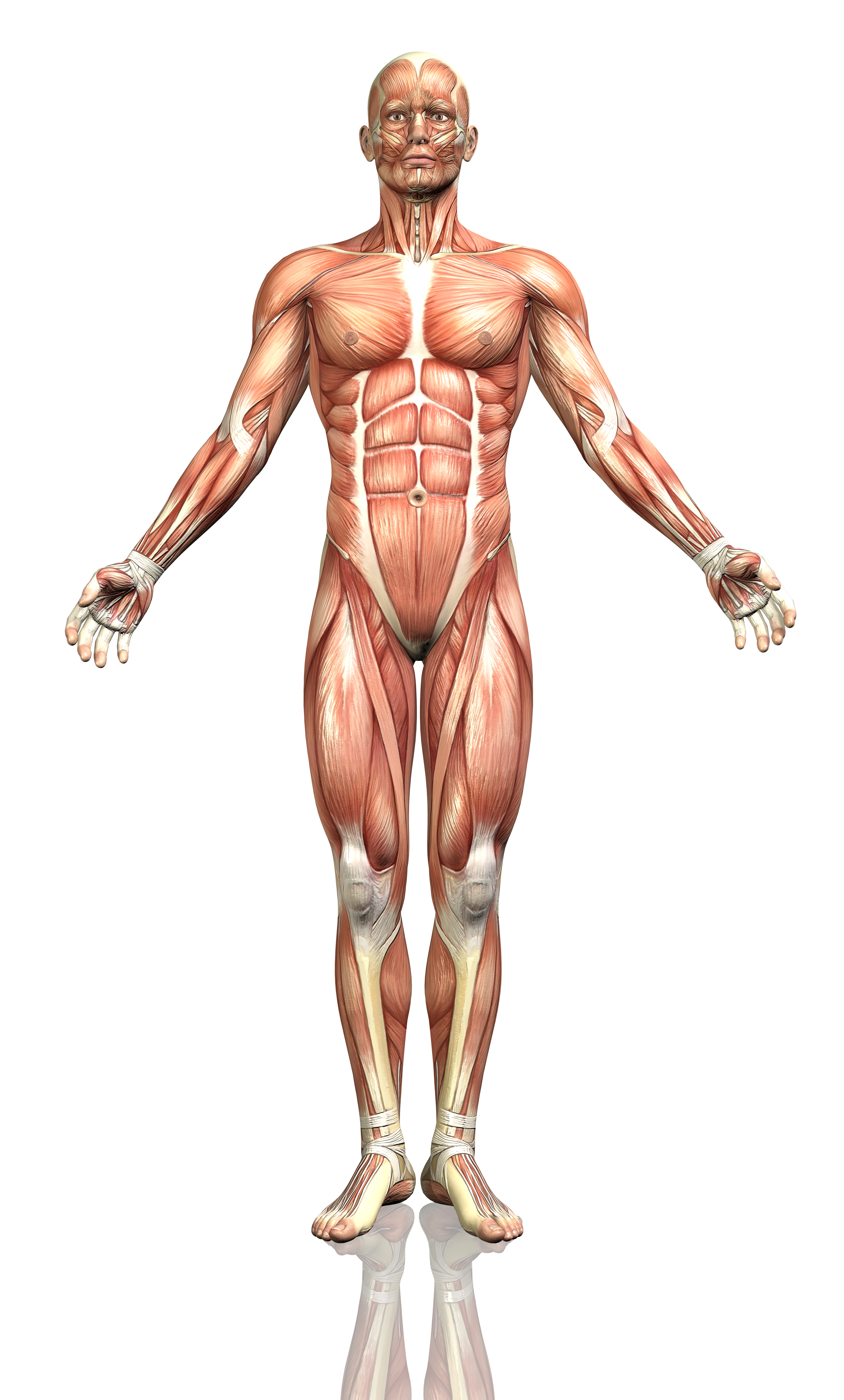
Display
Herniated or Bulging Disc of the Back/Lumbar Spine
A disc is a jelly-like, fluid filled sac that acts as a cushion between the bones of your back (vertebrae). Your discs change as you age, drying out and becoming more brittle. In addition, as the discs dry out with age, the change in height between the vertebrae decreases, causing changes in posture and function. In younger adults, the center of the disc (nucleus) is held in place by many rings of the disc (picture a cross section of a tree trunk). With minor or major injuries, poor posture and strain, these rings can rupture allowing a pressing outward of the disc nucleus. Finally, as the nucleus reaches the outer edges, the disc can begin to bulge, which in turn can rub and irritate nerve roots exiting your spine.

In more severe cases, the disc can become herniated, which further presses into the spaces where nerves are exiting. Symptoms can range from localized pain, to numbness/tingling to a specific part of the back, hips, legs, or feet. In more severe cases complete lack of sensation, muscle weakness, and paralysis of an area of the lower extremity can occur. Changes in posture, strength, and range of motion can all affect the positioning of the disc and how much bulging or herniation is occurring.
How physical therapy helps
The majority of bulging and herniated discs can be treated conservatively with physical therapy. By working with your medical history, symptoms, and testing, our physical therapists can determine what areas have been affected. A thorough plan is then created to relieve pressure on the disc by improving joint function, muscle strength, and posture. Our physical therapists will often use a McKenzie based treatment program to help centralize and abolish the symptoms. Modalities, such as traction, ultrasound, or electrical stimulation may be used to reduce pain, muscle spasms, or inflammation. Our physical therapists work with you to recover lost strength and range of motion. In addition, we then train you on the correct exercises to maintain good posture and reduce the risk of future episodes.
Fractures & Dislocations
Wrist Fractures
Fractures in the wrist and forearm area are common with falls, as the tendency is to protect oneself during the fall. Common fractures occur in the bones of the forearm near the wrist called the radius and ulnar. Two common fractures are called Colles’ fracture and Smith’s fracture. Colles’ fractures typically occur from falls onto an outstretched hand and Smith’s fractures occur from falling backward onto an outstretched hand.
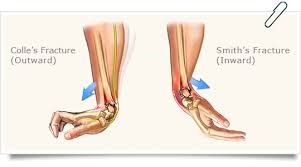
Another common fracture of the wrist and hand is the Scaphoid fracture, which is a small bone in the hand. The scaphoid bone connects with the radius bone of the forearm. Scaphoid fractures are more difficult to heal due to poor circulation to the bone itself.
Fractures are managed medically and depending on the type of fracture and severity, you may be placed into a cast or surgically repaired with pins, plates, or screws.
Elbow Fractures/Dislocations
Elbow fractures can occur as a result of a trauma, such as a fall while you’re playing sports or while you’re just walking on the sidewalk. Fractures due to falls happen most often when people stretch the arm straight out to catch themselves as they fall. When you fall on the ground, the force travels up through the wrist, hand, and forearm and into the elbow. Fractures can also occur if you fall directly on the elbow itself.
There are 3 types of bone fractures:
- Type I – a “nondisplaced” fracture, where the bone has a break but is still in normal position.
- Type II – a fracture where a fragment of bone is shifted from its normal position.
- Type III – the most serious type of fracture because there are multiple breaks of the bone.
Type I and II fractures usually are treated without surgery, but type III fractures usually require surgery.
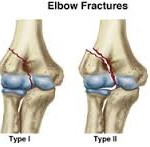
How physical therapy helps
During the healing phase typically in a cast or after surgery, the fingers, wrist, and elbow become very stiff, and range of motion and strength are lost. While in a sling or cast, our physical therapists may start you on exercises to help keep your shoulder, wrist, and hand joints loose. Physical therapy is very important in the rehabilitative process to help you regain normal range of motion, reduce swelling, resolve pain, and regain function of your hand and wrist.
Physical therapy is gentle and will help you quickly resolve your pain while working with your doctor to follow protocol and restore your function. With physical therapy, you can make a complete recovery quickly and safely.
Elbow Pain, Wrist Pain, Hand Pain
Elbow pain can come from a variety of sources, but typically occurs due to an overuse of the elbow joint from repetitive activities. Often bad posture with typing, writing, lifting, or sports, make the tissues around the elbow become irritated.
The elbow actually has quite a few different joints that move in very unique ways. The same bones (radius and ulnar) that make up the elbow also form the wrist and play a key role in the movements of the hands. Most of the muscles that make your wrist and fingers move are actually located in the forearm.
Poor posture, repetitive activities such as typing, gripping, and twisting can cause tightening in the muscles and tissues of the forearm. This can affect the mobility of the elbow, wrist, and even hands. This can lead to chronic inflammation and irritation to these areas.
How physical therapy helps
Physical therapy helps to relieve elbow pain, wrist pain, and hand pain by examining the mechanics of your joints and muscles. By identifying where you are having limitations, analyzing your daily activities, and strength of certain muscle groups, the root cause of your pain can be discovered.
A comprehensive plan is then built to improve your range of motion, reduce your pain quickly, soothe stiff and sore muscles, and return your strength. In addition, we work with you to educate you on techniques and exercises to prevent future injury or possibly adapt your work environment.
Sprain / Strain
Sprains and strains are very common in the hand, wrist, and elbow. Sprains refer to injuries of the ligaments (connect bone to bone) and strains refer to injuries of the muscles or tendons (connect muscle to bone). Sprains and strains occur from quick over-stretching of the tissues, causing micro-tearing and subsequent injury. Swelling begins as part of the inflammation process, causing pain and difficulty with movement.
The first step in treating sprains or strains in the wrist, elbow, hand, or fingers is to rest, ice, and elevate it. With severe limitations in movement, you should see your physical therapist right away. There are different levels of sprain or strain from mild to severe. In some cases, the tearing can be complete and even need surgical repair.
How physical therapy helps
In most cases, physical therapy can effectively help you recover from a sprain or strain. We first evaluate the injured area to determine the extent of the injury and ensure that the ligaments or tendons are still intact. After we pinpoint the injured area, we formulate a treatment plan that will quickly relieve your swelling/pain and begin restoring range of motion.
The goal of physical therapy is to restore your normal range of motion and eventually restore normal strength. If you participate in sports or are very active, we work closely with you to make sure that we help you fully recover and can participate in those activities you love to do.
Cubital Tunnel Syndrome
Ulnar nerve entrapment occurs when the ulnar nerve in the arm becomes compressed or irritated. The ulnar nerve is one of the three main nerves in your arm. It travels from your neck down into your hand, and can be constricted in several places along the way. Depending upon where it occurs, this pressure on the nerve can cause numbness or pain in your elbow, hand, wrist, or fingers.
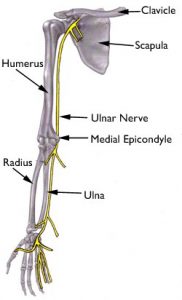
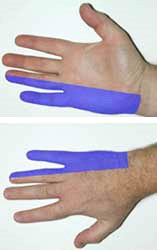
Sometimes the ulnar nerve gets compressed at the wrist, beneath the collarbone, or as it comes out of the spinal cord in the neck. The most common place where the nerve gets compressed is behind the elbow, also referred to as the area of the “funny bone”.
When the nerve compression occurs at the elbow, it is called “cubital tunnel syndrome”.
How physical therapy helps
Many cases of cubital tunnel syndrome can be treated without surgery. Our physical therapists will determine the activities that bring on your symptoms. The recommendations at this point will be to avoid those activities for a time. Remember, the nerve is irritated and at times swollen. If the irritation and swelling can be reduced, the symptoms should resolve.
In more advanced cases, our physical therapists will modify your activity and may recommend you use a splint to take the pressure off of the nerve. As your condition begins to improve, our therapists teach you:
Range of motion exercises to help return full length to the muscles that have shortened due to protective posturing, and to maintain the normal length of those that have remained unaffected.
- Muscle strengthening exercises to help restore the strength that has been lost over time. Our physical therapists will pick the exercises that are right for you.
- “Nerve gliding” exercises. Nerves actually have the ability to “stretch out”. Our therapists are educated in the proper positions for appropriate nerve stretches, and will work with you to ensure that safe and gentle stretching is achieved. In cubital tunnel syndrome, the nerve can become shortened; these exercises are an effective means of returning the nerve to its normal length.
- Sometimes surgery is required. The longer you have experienced symptoms and the more you experience weakness, numbness, tingling, and pain the more likely you are to need surgery. The goal of surgery is to relieve the pressure on the nerve.
Our physical therapists will design an individual program of post-surgical therapy based on the operation and the surgeon’s instructions. Each surgery will require a unique treatment regimen, but the post-surgical rehabilitation will involve many of the pre-surgical elements discussed above, with the exclusion of nerve gliding exercises. Activity modification will be a big part of your post-surgical rehabilitation to prevent recurrence of your symptoms.
Tendon Repair & Post-surgery Rehab
Common surgeries in the elbow, wrist and hand involve repair of the vast amount of tendons and ligaments in these areas. Depending on the type and extent of your surgery, your physician will recommend physical therapy to help you recover completely from your surgical procedure.
The fingers, hand, and wrist are very tightly packed with tendons, ligaments, and intricate structures. This means that swelling is very common in these areas after surgery and can become quite stiff leading to loss of range of motion, gripping, dexterity, and normal functioning of the fingers, hand, wrist, or elbow.
How physical therapy helps
We work closely with your physician and their protocol to ensure a complete recovery from your surgical procedure. Our gentle and specialized hands-on therapy manages the swelling in your fingers, hand, wrist, or elbow. The better this swelling is controlled, the faster your recovery can be. Per your surgical rehab protocol, we will progress your range of motion and eventually begin strengthening of the affected areas. Our goal is to make sure you have a complete recovery with good use of your fingers, hand, wrist, or elbow for everyday tasks.
Carpal Tunnel Syndrome
Carpal Tunnel Syndrome (CTS) is a very common condition and is becoming more frequent. The carpal tunnel is a narrow tunnel in the wrist where major arteries and nerves pass from the forearm into the wrist. One of the primary nerves that pass through this area is called the median nerve. When the tendons in the carpal tunnel become thickened, pressure is applied to the median nerve causing tingling, pain, and even loss of sensation to the thumb and first two fingers of the hand.
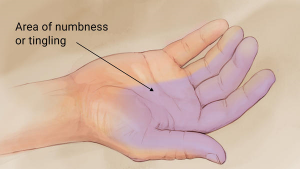
One of the primary causes of carpal tunnel syndrome is poor posture and repetitive activities such as typing at a computer in the wrong position for many hours a day. The direct pressure on the wrist from the desk along with the repetitive movement of the fingers can lead to a thickening of the carpal tunnel tendons.
Those at risk of developing carpal tunnel often have neck or shoulder problems on that side that lead to altered posture and movement of the arm. Since the median nerve exits from the neck and passes through the shoulder all the way down to your fingers, carpal tunnel is affected by the flexibility of the nerve higher up.
How physical therapy helps
Physical therapy is one of the first lines of defense in treating carpal tunnel syndrome. It is non-invasive and effective in eliminating symptoms and stopping them from returning.
Our physical therapy treatments focus on improving the mobility of the wrist and spacing of the carpal tunnel so the pressure is relieved on the median nerve. Hands-on treatments mobilize tight joints and stretch tight tendons. Astym treatments may also be utilized to decrease areas of tightness around the carpel tunnel area. Ultrasound and other modalities can reduce deep swelling relieving pressure on the nerve. Finally, strengthening and range of motion exercises can support the wrist and maintain good posture, helping the normal function of the median nerve.
We also focus on long-term results by training you on specific exercises to perform at home and work. Additionally, we train you on proper postural techniques to prevent future re-occurrences.
display
Your content goes here. Edit or remove this text inline or in the module Content settings. You can also style every aspect of this content in the module Design settings and even apply custom CSS to this text in the module Advanced settings.
Nerve Injuries
There are many nerves traveling along the elbow, forearm, wrist, and hand. With injuries to the hand, wrist, forearm, or elbow, nerve damage can result. Symptoms may be mild such as mild numbness, tingling, or abnormal temperature feelings. In severe cases, muscle function and paralysis can occur.
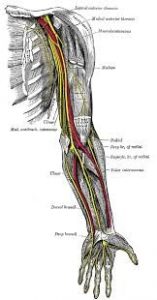
Many nerve injuries occur because of overuse and chronic swelling. This doesn’t allow proper circulation to flow to the nerves, affecting their functioning. Poor posture while doing common activities generally causes overuse injuries and chronic swelling. If you have significant nerve sensations into your arm, wrist, or hand, it is important to follow up with us and your physician.
How physical therapy helps
Physical therapy is very important to the healing aspect of nerve injuries. Whether mild from a small injury or severe after surgery, our experts work with you and your physician to facilitate your recovery.
The emphasis of physical therapy is on removing pressure from around the nerve by restoring normal tissue movement, joint movement,and range of motion. Our hands-on therapy serves to soothe and improve circulation, while stimulating nerves to restore normal function.
Tennis and Golfer’s Elbow (Lateral and Medial Epicondylitis)
Tennis Elbow
Tennis elbow is a common term for lateral epicondylitis. You don’t have to play tennis to develop this condition, it actually happens frequently with repetitive tasks done in poor postural positions, such as typing at too high of a desk. The muscles that extend your wrist and fingers actually attach to the bony outside of your elbow.
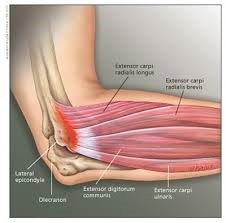
Typically with tennis elbow, severe tenderness will be present around the bony area on the outside of the elbow. This can cause pain with gripping objects, lifting objects, twisting of the forearm, and more.
Golfer’s Elbow
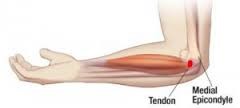 Golfer’s elbow is a general term for medial epicondylitis. This is similar to tennis elbow (lateral epicondylitis), except that it is on the inside bony area of the elbow. Reasons for this occurring are similar to that of tennis elbow where there is an overuse of the muscles that flex your wrist and fingers. These muscle tendons attach to the inside elbow bony area, and overuse results in irritation.
Golfer’s elbow is a general term for medial epicondylitis. This is similar to tennis elbow (lateral epicondylitis), except that it is on the inside bony area of the elbow. Reasons for this occurring are similar to that of tennis elbow where there is an overuse of the muscles that flex your wrist and fingers. These muscle tendons attach to the inside elbow bony area, and overuse results in irritation.
How physical therapy helps
Tennis elbow and golfer’s elbow can be treated very effectively with physical therapy. Modalities such as ultrasound and ice can assist with reducing swelling quickly in the irritated tendons. Furthermore, hands-on therapy for the tissues and joints such as Astym may be used to help to restore normal joint movement, break up any scar adhesions in the tissue, and bring circulation to the area to promote healing.
As the pain subsides, the focus is shifted to making sure your proper range of motion in the elbow and wrist are returned to normal. Gentle strengthening programs are started to help support the affected area and regain your strength. In addition, we educate you on proper posture and techniques to manage work and repetitive activities so the condition does not continue.
Trigger Finger
Stenosing tenosynovitis, commonly known as “trigger finger” or “trigger thumb”, involves the pulleys and tendons in the hand that bend the fingers. The tendons work like long ropes connecting the muscles of the forearm with the bones of the fingers and thumb. In the finger, the pulleys are a series of rings that form a tunnel through which the tendons must glide, much like the guides on a fishing rod through which the line (or tendon) must pass. These pulleys hold the tendons close against the bone. The tendons and the tunnel have a slick lining that allows easy gliding of the tendon through the pulleys (see Figure).
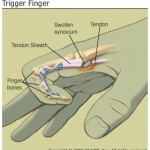 rigger finger/thumb occurs when the pulley at the base of the finger becomes too thick and constricting around the tendon, making it hard for the tendon to move freely through the pulley. Sometimes the tendon develops a nodule (knot) or swelling of its lining. Because of the increased resistance to the gliding of the tendon through the pulley, one may feel pain, popping, or a catching feeling in the finger or thumb. When the tendon catches, it produces irritation and more swelling of the pulley. This causes a vicious cycle of triggering and thickening of the pulley. Sometimes the finger becomes stuck or locked and is hard to straighten or bend.
rigger finger/thumb occurs when the pulley at the base of the finger becomes too thick and constricting around the tendon, making it hard for the tendon to move freely through the pulley. Sometimes the tendon develops a nodule (knot) or swelling of its lining. Because of the increased resistance to the gliding of the tendon through the pulley, one may feel pain, popping, or a catching feeling in the finger or thumb. When the tendon catches, it produces irritation and more swelling of the pulley. This causes a vicious cycle of triggering and thickening of the pulley. Sometimes the finger becomes stuck or locked and is hard to straighten or bend.
How physical therapy helps
The goal of treatment in trigger finger/thumb is to eliminate the catching or locking and allow full movement of the finger or thumb without discomfort. Swelling around the flexor tendon and tendon sheath must be reduced to allow smooth gliding of the tendon. Physical therapy may include Asytm treatment to decrease fibrosis around the tight tendons, as well as modalities of phonophoresis or inotophoresis to decrease inflammation. The wearing of a splint or taking an oral anti-inflammatory medication may sometimes help too. Treatment may also include changing activities to reduce swelling. An injection of steroid into the area around the tendon and pulley is often effective in relieving the trigger finger/thumb. If non-surgical forms of treatment do not relieve the symptoms, surgery may be recommended.
De Quervain's Tendinitis
De Quervain’s (dih-kwer-VAINS) tendinitis is a condition that causes pain and tenderness at the thumb side of the wrist, at the base of the thumb and forearm. Pain is worsened with grasping or extending the thumb (pulling it back like “thumbing a ride”). People of all ages can develop this condition, which usually happens when the tendons are strained by prolonged or repetitive use of the hand, rapid or forceful hand use, or use of the hand or arm in an awkward position. Tendons at the wrist become irritated and thickened, resulting in pain when moving the thumb and grasping objects.
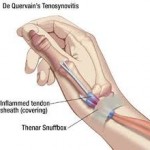
How physical therapy helps
Our physical therapists can provide specific instructions to avoiding repetitive thumb and/or wrist movements, avoid flexing the thumb, and avoid moving the hand toward the pinkie finger as much as possible. You should also avoid forceful hand movements, and any movements or activities that increase pain. Our therapists may provide a wrist splint to position your wrist and thumb for rest, as well as to provide compression to help pain and swelling. We may also work with you to reduce pain and inflammation through the use of Astym treatment, ultrasound, or iontophoresis. If your symptoms do not respond to conservative care, our physical therapists will refer you to a physician who will determine if you need medication, injection, or surgical care for further recovery.
Loose Bodies
Loose bodies of the elbow joint usually consist of pieces of cartilage or bone fragments. Injury, overuse, and age-related wear and tear are responsible for most elbow problems. Elbow arthroscopy (surgery) may relieve painful symptoms of many problems that damage the cartilage surfaces and other soft tissues surrounding the joint. Elbow arthroscopy may also be recommended to remove loose pieces of bone and cartilage, or release scar tissue that is blocking motion.
How physical therapy helps
Rehabilitation plays an important role in getting you back to your daily activities. An exercise program will help you regain elbow and forearm motion and strength. Your surgeon will develop a rehabilitation plan based on the surgical procedures you required.
Our physical therapists will instruct you or a family member with basic exercises to begin at home a few days following surgery to facilitate motion, strength, and return of function of the elbow. The type and duration of physical therapy will depend on the type of problem you have and the type of surgery you required.
Return to driving, basic activities of daily living, and return to work will depend on the type of surgery you required and should be discussed with your doctor prior to surgery.
